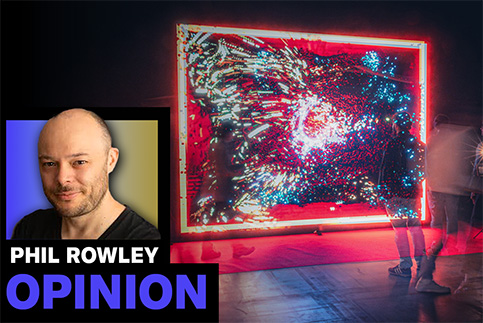The futurist’s best-kept secret

Opinion
When it comes to the future, are we looking in the right place? Slush offers a glimpse of the next decade in technology that, in turn, may mould the businesses and consumers of the 2030s.
At The Media Leader’s The Year Ahead event earlier this month, we pondered how we could get better at seeing into the future.
As an illustration, consider the streetlight effect, a behavioural science anecdote where Peter finds Paul searching for his lost keys under a streetlight. When Peter learns Paul actually lost the keys in a distant park, he asks why he is searching here and not there. Paul replies: “Because the light is better here.”
Agencies about to delve into their 2025 trends reports must ask themselves: when it comes to the future, are we looking in the right place? Or just where the light is?
At Omnicom Media Group Futures, we’ve always sought to look for the future far away from the glare of the streetlight. It’s led to the discovery of the most fantastic “secret source” of future forecasting. And we’re sharing it here.
Mindsets, not handsets
For three years, OMG has been exploring an absolute goldmine of future insights at the Slush startup conference. For us, it’s the best-kept secret in media. Not because it has anything to do with media or marketing — it doesn’t — but because it is a brilliant glimpse of the next decade in technology. And that in turn may mould the businesses and consumers of the 2030s.
Hosted in a darkened laser-lit arena in a freezing Helsinki every year, Slush is primarily an event for venture capital funds to find, and fund, the next big thing in tech — with 5,500 exhibitors vying for the attention of investors totalling $3tn in funds between them. And by big, we really mean big. Planetary-scale innovations from AI to sustainability to biotech to transport. It’s the kind of tech envisaged in the pages of sci-fi novels for decades previous.
For a media or marketing agency, the relevance may not be immediately clear. And so the skill is in analysing these startups to determine a direction of travel for global society — almost like a techno-social compass.
In this sense, Slush is less about the shiny new devices on which we’ll be consuming our content or how we’ll use them for advertising, and more about how our lives will be impacted by the tectonic movements of markets, machines and mother nature. In short: mindsets, not handsets.
Welcome to ‘perma-nostalgia’: How the digital age keeps our past alive and profitable
Themes, not trends
Across the conferences we’ve attended, and the client reports we’ve then written, it’s notable that Slush deals in themes, not trends. Themes can flex and bend to winds of change. Trends can be fleeting. Themes endure. Trends often do not.
We see Slush present the future as a work-in-progress, anchored by consistent themes that endure, yes, but also take on a new accent or focus point year on year as the world flows and evolves.
For our 2025 report, all startups embodied ideas of unity, of integration, of augmentation. But they fall into the following key themes:
- Media fusions — startups cross-pollinating media formats to deliver new hybrid content experiences
- Accelerated business brains — how businesses will clamour to integrate proprietary AI at the heart of operations to supercharge their employees
- Green horizons — resilient sustainability startups are working collectively on modest, pragmatic and incremental innovations to win back the planet
- Augmented humans — a tech union of humankind and machine is inevitable to optimise both our bodies and our brains
- Trust by design — innovations that may help return trust and safety to our digital interactions in a world blighted by deep fakes and fake news
Slush paints a picture of how the business of the future will operate in a radically different paradigm: where machine augmentation is accepted, sustainability is standard and consumers are empowered and protected. To be ready, we must start that journey with clients now.
AI creativity is about raising the floor as well as the ceiling
Foresight, not hindsight
The above might seem another perfunctory addition to the New Year chat about what comes next. But, again, Slush seems to have a better track record for prediction than most — a kind of techno-clairvoyance for how its themes make their way into mainstream consciousness some time later.
For example, in years past, we’ve foreseen and reported on gen-AI coding games. In December 2024, this issue came to public prominence when Google DeepMind unveiled Genie 2, an AI that generates playable 3D worlds. Slush seemed, quite literally, ahead of the game.
We’ve previously identified startups striving to create “green AI” to combat the heavy environmental footprint of AI — an issue that gained real prominence in 2024 and likely to affect businesses that go “all in” on AI moving forward.
We also witnessed technologies that push for the “perfect virtual try-on” for fashion items and recently witnessed this go mainstream after it became available through gen-AI platform Kling.
Slush’s tagline should be: “You saw it here first.”
Hopeful, not hopeless
Most important, though, is that Slush represents an inherent optimism or hunger for the challenge. That’s heartening. It implies that the future at least has the potential to be better than the present.
Slush is perhaps the most optimistic yet realistic source of future thinking. While it is not under the streetlight, it is where the keys are.
 Phil Rowley is head of futures at Omnicom Media Group UK and author of Hit the Switch: The Future of Sustainable Business. He writes a monthly column for The Media Leader about the future of media
Phil Rowley is head of futures at Omnicom Media Group UK and author of Hit the Switch: The Future of Sustainable Business. He writes a monthly column for The Media Leader about the future of media




